Cabo de Gata-Níjar Natural Park
| Cabo de Gata-Níjar | |
|---|---|
|
IUCN category V (protected landscape/seascape) | |
|
Arrecife de las Sirenas | |
  | |
| Location | Spain |
| Nearest city | Almería |
| Coordinates | 36°47′00″N 02°06′00″W / 36.78333°N 2.10000°WCoordinates: 36°47′00″N 02°06′00″W / 36.78333°N 2.10000°W |
| Area | 460 km2 |
| Established | 1997 |
| Visitors | 500,000 (in 1998) |
| Governing body | Junta de Andalucia |
| Official name | Salinas del Cabo de Gata |
| Designated | December 5, 1989 [1] |
Cabo de Gata-Níjar Natural Park in the southeastern corner of Spain, is Andalucia's largest coastal protected area, a wild and isolated landscape with some of Europe's most original geological features. Spain's southeast coast, where the park is situated, is the only region in Europe with a true hot desert climate (Köppen climate classification: BWh).
The eponymous mountain range of the Sierra del Cabo de Gata with its highest peak El Fraile is Spain's largest volcanic rock formation with sharp peaks and crags in red and ochre-hues. It falls steeply to the Mediterranean Sea creating jagged 100-metre (330 ft) high cliffs, which are riven by gullies leading to hidden coves with white sandy beaches, some of the most beautiful in Andalucia.
Offshore are numerous tiny rocky islands and underwater extensive coral reefs teeming with marine life.[2] Its climate is arid to the extent of being the driest location in Europe and within a region which has the continent´s only subtropical or "hot" desert, with rainfall below 200 mm (7.9 in) a year and average yearly temperatures above 18 °C (64 °F). In 1997 it was designated as a UNESCO Biosphere Reserve. In 2001 it was included among the Specially Protected Areas of Mediterranean Importance. In 2010 it was proposed as a dump for nuclear waste.[3]
The name Cabo de Gata relates to the mineral agate that used to be mined in this area.
Geology, geography, climate, and vegetation

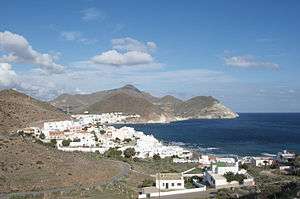

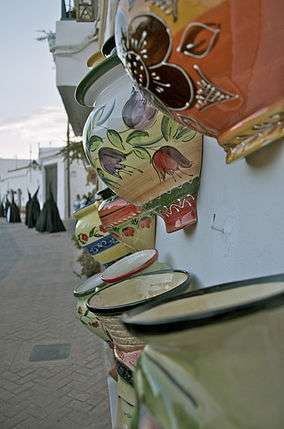

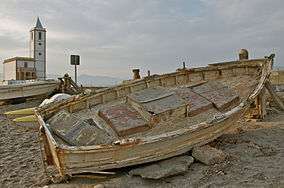
Cabo de Gata-Níjar Natural Park is characterised by volcanic rock formations - lava flows, volcanic domes, volcanic calderas. The park joined UNESCO's Global Geoparks Network in 2006, and is also a member of the European Geoparks Network. [4]
Between the village of San Miguel and the Cabo de Gata point are salt flats (Las Salinas de Cabo de Gata) separated from the sea by a 400 m (1,300 ft) sand bar. The salt flats are a Ramsar site.
Its coasts have seagrass beds of the Posidonia genus and offshore coral reefs, both dramatically increasing the numbers of resident and transient marine species. A 120 km2 (46 sq mi) part of the total designated protected area is a marine reserve, extending underwater to a depth of 60 m (200 ft).
The area has an arid climate with an average temperature of about 19 °C (66 °F) and an average annual rainfall of 156 mm (6.1 in), recorded at the Faro del Cabo de Gata (36°43'18.8 N, 2°11'34.69" W) during the period 1961-1990.[5]
The characteristic vegetation in the terrestrial zone is drought-adapted flora: largely agave, prickly pear, dwarf fan palms, and a number of xerophytes (some of which are endemic). There is Posidonia seagrass in the marine zone.
Human impact on the park
Historically, due to the harsh conditions for agriculture and its isolated location, habitation has been sparse and this has kept the area relatively unspoilt, an unusual feature along the Spanish Mediterranean coast. 3,500 people were recorded as living within the boundaries in 1997. The natural park protection it now receives promises to keep residential expansion under control. Dotted around the natural park are abandoned farms, houses, factories, and sometimes, whole villages dating back to various periods in time. The exact reasons for the abandonment are not clear, but it is thought that the harsh conditions for agriculture together with questionable permissions to build and the prevailing economic climate at the time, would be major factors. Sadly, this is something that continues to this day with perhaps the most infamous example being the Algarrobico.
In 2003 a hotel project was started at Playa del Algarrobico between Carboneras and Mojacar, just inside the park. Work on the project was halted,[6] but demolition, which is opposed by 14 municipalities, has yet to be carried out.[7] Several reputable sources claim with good evidence, that this project is an illegal development although it seems that more recently demolition plans are moving closer.[8]
There are also a number of abandoned villages and buildings that are considered to be of historical importance and so remain as they have been left. Good examples of this are the deserted mining villages around Rodalquilar.[9] Although the villages or "ghost towns" and the former gold mines are a blot on the landscape, they are a big attraction and there have even been concerts hosted at the site of the former gold mine.
Sadly there are also a number of national treasures that lay to ruin and an example of this is Cortijo del Fraile. Every now and then there is a move to restore it, but as yet, nothing has happened except a few efforts to raise money.[10]
Tourism
Tourism continues as one of the biggest industries in the Parque Natural de Cabo de Gata with huge numbers of visitors from all over the world coming mainly during the spring and summer months. In 1998 there were 500,000 tourists visiting the area and although the number of visitors has declined in the past year (2011/2012) due to economic conditions across Europe, tourism still remains strong.
Over recent years there has been a trend toward Sustainable / Eco Tourism and visitors can enjoy environmentally-friendly outdoor activities such as bird watching, photography experiences, geological field-trips, as well as the more established diving and boat excursions. There are a number of arts and crafts based on local traditions that are still carried out around the Parque Natural de Cabo de Gata and especially so in the beautiful little Moorish “pueblo blanco” of Níjar. The traditional arts and crafts include ceramics, pottery, carpet making and woven goods (baskets, hats, shoes, etc.) made from esparto grass. The same arts and crafts are found in many different places around the natural park alongside painting, sculpture, and photography. Also one may find in several of the pueblos, craft market stalls selling hand-made (hecho de mano) jewellery, leather goods, clothing, and incense holders, in addition to local shops selling local produce such as olive oil, wine, almonds, tomatoes, and so on.
There also has been an increase in the number of health retreats that offer holistic therapies, meditation, and yoga.
While the hiking network is not extensive, there are a number of senderos that provide for some good day hikes. The Caldera de Majada Redonda is one such trail that leads to the center of an ancient volcano caldera.
Towns
There are some small towns in the Cabo de Gata area.
Agua Amarga
Translated from the Spanish, Agua Amarga literally means, bitter water. This name dates back to when trains used to bring minerals from the mines in the Sierra Alhamilla and chemicals used in the mining process would taint the wells in the town.[11] These days Agua Amarga is one of the hot-spots for visitors to the Parque Natural de Cabo de Gata. It is a pretty little seaside town and fairly expensive in comparison to other towns or pueblos in the natural park. There is one fairly extensive beach, a number of very nice restaurants and hotels.
This small village is surrounded by many small beaches with cristaline water and great submarine life, perfect for snorkelling. In the past few years many famous people have chosen this spot to spend their holidays because of its paradise coast.
Cabo de Gata
The strip of beach known as Playa de San Miguel and the adjacent road stretches from the small village of Cabo de Gata to La Fabriquilla before ascending a tiny mountain pass toward the Arrecife de las Sirenas and the stunning beaches beyond. This coastal strip is generally known as Cabo de Gata although it comprises several little smaller villages (pueblitos) including Cabo de Gata, Almadraba de Monteleva, and La Fabriquila. There are a number of hotels and places to eat and drink along this beach. At Almadraba de Monteleva are the salt works that are still operational, next to the salt works are the ram shackled and salt-blasted houses of former workers, some of which are still occupied. Opposite these houses is the curious church of San Miguel. Behind the salt-works are the lagoons known as Las Salinas de Cabo de Gata, as previously mentioned. Cabo de Gata has tradition of fishing, which continues to this day, and there are a number of old fishing boats that have been left along the Playa de San Miguel as artifacts of days gone by. These are said to have an important ethnological value and so are left as a "living museum".
Carboneras
The pueblo of Carboneras is located near to the eastern-most border of Parque Natural de Cabo de Gata and is a fairly large town.
Carboneras has a convivial atmosphere and night-life almost throughout the year as it is a major seaside town. The main town has fine beaches. Located just a little out-of-town and en route to Agua Amarga, is the popular naturist beach of Playa de los Muertos (the Beach of the Dead), which is reported to have been voted one of the country's top beaches. Carboneras is also known as a town of live music due to the Teatro de Musica and a number of other smaller venues hosting live music all year round. At its western edge it has an industrial area that combines a power station, a large cement works, one of Europe's largest desalination (reverse-osmosis) plants and a port, all of which pre-date the setting up the national park. The power station has been used for carbon capture research. Whilst the desalination plant, provides water to the local communities, as well as the burgeoning green house based vegetable industry.
Las Negras
Las Negras is a little different from the other pueblos in Parque Natural de Cabo de Gata. It is a peaceful yet lively little sea-side village towards the eastern end of the natural park and just to the west of Agua Amarga. Las Negras has some rather odd buildings that are very 1970s in appearance because it has been developed in a more modern style to other towns. Despite its size, there is a lively night-life and some great places to eat and drink and enjoy live music. Las Negras is a bit of a haven for the more bohemian type of person and has a lovely beach on which to sit and watch the world go by. From Las Negras there is a footpath to Cala de San Pedro, which takes about 40 minutes to an hour to walk or one may take a boat.
Los Albaricoques
Any movie buff will recognise Los Albaricoques as being the pueblo of Agua Caliente in the seminal films (movies) of Sergio Leone. The final shoot out in the film For a few dollars more took place in the centre of Los Albaricoques. The economy of Los Albaricoques relies heavily on the agriculture that surrounds the village and arguably, some of the best tomatoes from Spain are grown in this area, notably the 'Raff'. There is only one shop and two bars in Los Albaricoques. One of these bars Hostal Alba, is a mecca for film / movie buffs and a tribute to the village's cinematic history. Not far from the pueblo of Los Albaricoques is the infamous Cortijo del Fraile, the backdrop for Federico Garcia Lorca's seminal play, Bodas de Sangre (Blood Wedding), which features a crime of passion that took place close by.
Níjar
Níjar has been described as one of the most picturesque towns in the whole of Spain and is known for its superb handcrafts in pottery and carpets. Located inland and on the northern edge of the natural park, it comes highly recommended as a place to see and should be on any self-respecting visitor’s itinerary. The visit is made all the more pleasant thanks to the many reasonably priced bars and restaurants offering delicious local dishes. There are also affordable hostels and hotels in and around Níjar. It is well worth visiting Níjar during the processions of Semana Santa (Holy Week). In the bigger towns and cities around Spain, these processions are quite lavish including at times some very intricate animatronics but in smaller towns, such as in Níjar, they are much more “earthy” affairs.[12]
Rodalquilar
The tranquil town (pueblo) of Rodalquilar sits peacefully in the middle of the Parque Natural de Cabo de Gata and is a haven for the local artistic community. There are a number of unique independent galleries dedicated to showing off painting, photography, pottery, and ceramics. Rodalaquilar is a sleepy town with some very nice places to eat and stunning beaches and couldn’t be more different from its past, for it is known in the province of Almería for ancient mines of gold![9] A trip to the natural park is not complete without a visit to the goldmines and abandoned miner villages. One of the more popular "must see" beaches near Rodalquilar is Playa el Playazo. In common with many of the beaches in the middle and toward the western end of the natural park, the sea is normally crystal clear and perfect for snorkelling or diving.
San José
San José is a very beautiful little fishing port in the centre of the natural park. Over recent years it is seeing an increase in the number of visitors and is an easily accessible town from Almería airport and the A7 autovia. San José, as with all of the Parque Natural de Cabo de Gata, is beautiful all-year round, but most popular during the spring and summer months. Although San José boasts a few nice beaches, a little outside the town and within walking distance, are some of the most amazing and picturesque beaches -mostly nudist- in the natural park such as Playa de los Genoveses, Playa de Mónsul and Cala de la Media Luna. There are several good restaurants and excellent tapas bars in San José. The local independently run tourist office is a very good reference point for activities in the Parque Natural de Cabo de Gata. Accommodation is plentiful although in summer some places can be fairly expensive and are quickly filled. San José along with Las Negras is a bit of a haven for the more bohemian type of person and enjoys a chic riviera type atmosphere.
Various other
There are a number of smaller towns and villages in the Parque Natural de Cabo de Gata that are worth mentioning and each with its own charm and historical or ethnological importance. Campohermoso, Fernán Pérez, Isleta del Moro, Los Escullos, Pozo de los Frailes, and San Isidro are just some of them. Isleta del Moro and Los Escullos are particularly interesting as they are along the coast and have some stunning, if not smaller beaches. There is a network of footpaths (senderos) that connect all the seaside towns and pueblos.
Flora
015.jpg)
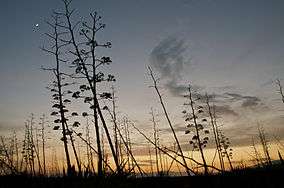
There are more than 1,000 plants recorded in the reserve, some of which are endemic to the Parque Natural de Cabo de Gata and some of which have become symbols of the natural park.
European fan palm
The European fan palm (Chamaerops humilis) is a shrub-like clumping palm, with several stems growing from a single base. It is the only palm species native to continental Europe and is mainly found in southwestern Europe (Spain, Portugal, Italy, Malta and certain locations on the Mediterranean coast of France) and northwest Africa (Morocco, Algeria, Tunisia). Europe's only native palm, supplements the meagre groundwater supplies with dew and airborne moisture.
Agave (Pita) Americana
One of the most familiar plant species in the natural park is Agave (Pita) Americana, a native of tropical America and Mexico. Common names include century plant, maguey (in Mexico), or American aloe (it is not, however, closely related to the genus Aloe). The name "century plant" refers to the long time the plant takes to flower. The number of years before flowering occurs depends on the vigor of the individual plant, the richness of the soil, and the climate; during these years the plant is storing in its fleshy leaves the nourishment required for the effort of flowering.
Dragoncillo del Cabo
Some of the plants endemic to the Parque Natural de Cabo de Gata include the pink snapdragon (Antirrhinum charidemi), known to the locals as the Dragoncillo del Cabo.
Other plants
Iberia's largest population of jujube (Ziziphus zizyphus), a thorny shrub, populates the steppe and is known locally as Azofeifa. The scrubland is composed of olive trees (Olea europaea), mastic (Pistacia lentiscus), Kermes oaks (Quercus coccifera), esparto grass (Stipa tenacissima), thyme (Thymus) and rosemary (Rosmarinus officinalis).
Around the salt flats are colonies of saltworts, common reeds (Phragmites australis) and the glasswort (Salicornia fruticosa). In the coastal waters are extensive beds of seagrass (Posidonia oceanica), which is endemic to the Mediterranean, and 260 species of seaweed.
Fauna
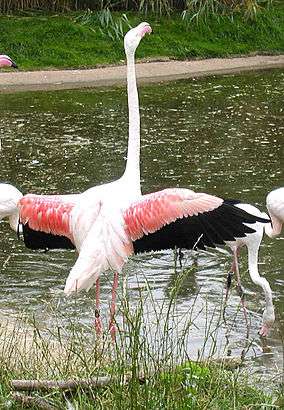

1,100 species of fauna have been recorded within the park, the majority of which are birds. The European Union has designated a Special Protection Area for bird-life. The salt flats provide an important habitat for both the resident birds and the thousands of migrating birds who stop on their journey between Europe and Africa. Species found around the salt flats include flamingos (Phoenicopterus roseus); grey (Ardea cinerea); purple herons (Ardea purpurea); storks; cranes; waders including avocets and oystercatchers; and overwintering ducks.
Many species of lark live on the steppe, including the rare Dupont's lark (Chersophilus duponti) and there are also little bustards (Tetrax tetrax) and stone curlews (Burhinus oedicnemus). Sea birds include yellow-legged gulls (Larus michahellis), terns, razorbills (Alca torda), shags, the occasional puffin (Fratercula arctica) and Cory's (Calonectris diomedea) and Balearic shearwaters (Puffinus mauretanicus). The wealth of animal life provides prey for a number of raptors: ospreys (Pandion haliaetus), peregrine falcons (Falco peregrinus), kestrels (Falco tinnunculus), and eagles.
Approximately 15 species of reptile are found in the park, including Italian wall lizards (Podarcis sicula) (uniquely in Spain), ocellated lizards (Timon lepidus), grass snakes (Natrix natrix), and Lataste's viper (Vipera latastei).
The maritime reserve is home to various species of crustaceans, molluscs, and fishes including the common cuttlefish (Sepia officinalis), the Pinna nobilis clam that produces sea silk, the Mediterranean moray (Muraena helena) that was regarded as a delicacy by the Romans, the garfish (Belone belone), and flying gurnard (Dactylopterus volitans), which uses its enlarged pectoral fins to "walk" along the ocean floor. Seaweeds host fish such as bream and grouper.
Among the mammals in the park are common genets (Genetta genetta), wild boar (Sus scrofa), the garden dormouse (Eliomys quercinus), and the least weasel (Mustela nivalis), the smallest terrestrial mammalian carnivore. The seagrass used to provide a habitat for the endangered monk seal (Monachus monachus). Up until the 1960s it was one of the last locations where this seal bred in Spain, the islet of Tabarca being the other. Although occasionally sighted offshore, no seals have bred in the park since 1965.[13]
See also
Notes
- ↑ "Ramsar List". Ramsar.org. Archived from the original on 9 April 2013. Retrieved 16 April 2013.
- ↑ "Cabo de Gata Photography: Cabo de Gata". Martyn Thompson (Cabo de Gata Photography). 2012. Retrieved 2012-11-26.
- ↑ "Nuclear dump study starts in Cabo de Gata"
- ↑ European geoparks website Archived 2009-05-30 at the Wayback Machine.
- ↑ Capel Molina, J.J. (1995) Mapa pluviométrico de España Peninsular y Baleares (en el periodo internacional 1961-1990) Investigaciones Geográficas nº 13: 29-466ISSN 0213-4691 pdf Idioma: español. Acceso: 3/7/2009.
- ↑ "Algarrobico the never ending story".
- ↑ "14 Almería villages against the demolition of the El Algarrobico Hotel".
- ↑ "Algarrobico hotel approaches demolition". The Olive Press. 2012-07-26. Retrieved 2012-11-26.
- 1 2 "After the Goldrush". Martyn Thompson (Cabo de Gata Photography). 2012-06-17. Retrieved 2012-11-26.
- ↑ "Nijar town hall joins with owners of Cortijo del Fraile to save farmhouse which inspired Lorca’s Blood Wedding". The Olive Press. 2012-02-07. Retrieved 2012-11-26.
- ↑ "The Lucainena to Agua Amarga line". Don Gaunt. Retrieved 2012-11-26.
- ↑ "Semana Santa". Martyn Thompson (Cabo de Gata Photography). 2012-04-07. Retrieved 2012-11-26.
- ↑ "Monachus Monachus" (PDF) (in Spanish). Ministerio de Medio Ambiente (Ministry of the Environment). 2006. Retrieved 23 November 2006.
External links
- "Cabo de Gata Natural Park. Almeria. Spain". Cabo de Gata-Níjar Natural Park. Retrieved 20 November 2006.
- "Cabo de Gata Nature Reserve.". Cabo Gata Spain. Retrieved 7 September 2014.
- Jo Williams. "Natural Parks - Almeria Province: Cabo de Gata-Níjar Natural Park". Andalucia.com. Retrieved 20 November 2006.
- Nicolas B. Langlade; Xianzhong Feng; Tracy Dransfield; Lucy Copsey; Andrew I. Hanna; Christophe Thébaud; Andrew Bangham; Andrew Hudson; Enrico Coen (2005-07-11). "Evolution through genetically controlled allometry space". Proceedings of the National Academy of Sciences USA. 102 (21): 21–26. PMC 1177394
 . PMID 16009935. doi:10.1073/pnas.0504210102.
. PMID 16009935. doi:10.1073/pnas.0504210102.
| Wikimedia Commons has media related to Parque Natural de Cabo de Gata-Níjar. |
| Wikimedia Commons has media related to Deserts of Spain. |
